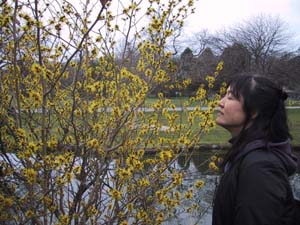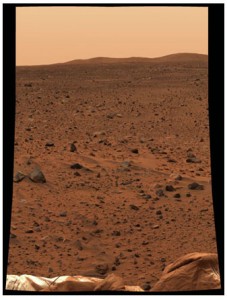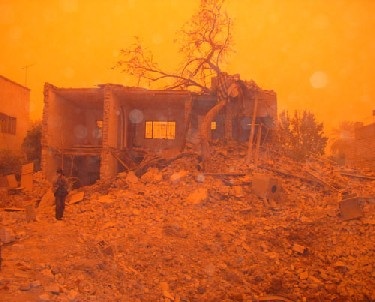|
|

wild kale
Kale seems to be one of the most vigorous food plants in the world. It’s tremendously good for you and it kind of just grows itself. Once it’s planted it keeps seeding itself out. Here on the west coast, it provides people with fresh green vegetables all winter long. Kale tastes better in the winter because the leaves concentrate sugars which also serve as a natural antifreeze. Former students of mine have been scattering kale seed from Cortes Island, all over the Lower East Side of New York which is now growing into kale that people can eat. I found the wild specimen in the picture, growing beside a parking lot in Victoria BC. Kale is a wonderful vegetable symbiot. The kale varieties in my backyard are constantly cross-breeding and seem to self organize and *evolve* to deal with drought, pests and exposure to cold. Raoul Robinson in his radical book Return to Resistance, promotes this kind of anarchic botanical promiscuity as a way of inducing *horizontal resistance* in agricultural crops. Robinson’s breeding technique of *recurrent mass selection* creates a high degree of genetic variability from a large gene pool within the crop to allow it to adapt to continually changing conditions of pests and disease. This is the exact opposite of traditional plant breeding, which aims to create uniform genetics, and characteristics. There is a vigorous movement of plant hackers who are busy working against the *great homogenization* of our food supply being instigated by multi-national agro-business. One of the foremost of these is “open source” seedsman J.L Hudson (aka David Theodoropoulos). His catalog features amazing seeds but also his fascinating and insightful writings on biodiversity, for example his manifesto:
We recognize that the biological diversity of the Earth and the diversity of all cultivated species are the common heritage of all humanity and we REJECT the theft of the biological commons by individuals, corporations and governments through plant patenting, gene patenting, Plant Breeder’s Rights (PBR), Plant Variety Protection (PVP), or any other form of intellectual property applied to living things. We reject life patenting in any form . . .
The parallel to the Open Source software movement is striking here and it would seem reasonable that botanical otaku and computer hackers form alliances against the privatization of the genetic and intellectual commons. (More on this to come . . .) Hudson’s explicitly “uncopyrighted, all rights released” catalog reflects his attitude towards open source botanical germplasm. Maybe he should put a Creative Commons license on it. It’s worth sending away for his catalog just for the narrative! Here is a sample entry:
‘POMEGRANATE’ Spectacular brilliant deep orange-red flowers 1-2″ across, sometimes reaching 4″, from succulent scarlet buds. satiny crinkled petals surround gold-tipped stamens. The apple to grapefruit-sized red fruits are filled with seeds, each surrounded by red, juicy pulp resembling a mass of rubies when the fruit splits open. Tree or shrub 6 -25 feet, with attractive glossy narrow foliage, bronze when young. W. Asia. Grown for its delicious fruit since ancient times, it is mentioned in the Ebers Papyrus, and by Homer, Pliny and Theophrastus. Wine was made from the juice in Ancient Egypt, and used to make ‘Grenadine’ today. The Greeks believed it to have been brought by Aphrodite, and the fruit is to have kept Proserpina from returning to earth, hence the origin of winter. The Phoenicians and Syrians used the fruit and bark for tanning. It was grown in the Hanging Gardens of Babylon, and it is the national emblem of Spain. Black ink can be made from the rind, and red cloth dye from the flowers. The wood is hard. Can live several hundred years. The rind and bark are well known as vermifuges, and used against dysentery.
Perhaps most endearingly, Hudson (like me) hates telephones, warning potential callers that: “I HAVE NO BUSINESS OR PERSONAL TELEPHONE . . . If your ‘phone doesn’t ring, its me!”
While on the topic of the politics of food, Richard Manning has written an insightful article The Oil We Eat – Following the Food Chain back to Iraq in the February 2004 edition of Harper’s Magazine. In it, Manning does a damning energy audit of the effect of grain agriculture throughout the ages and describes how our reliance on petro-chemical based nitrogen fertilizers is pushing us toward the precipice of environmental and geopolitical catastrophe.
Forget the polysyllabic organics. It is nitrogen -the wellspring of fertility relied upon by every Eden-obsessed backyard gardener and suburban groundskeeper -that we should fear most
Tofu comes across as looking pretty bad in his analysis and Manning winds up making a good case for bagging the occasional venison.
Maybe it’s because of the New Year but I’m becoming more and more obsessed with how to *find my stuff* and then to see *how it’s all connected.* Surfing the net has yielded some interesting approaches:
Geisha asobi recently posted this interesting link to the home page of the Japanese design firm, Intentionallies. The page is a simple flash animation that scatters little picture cards of the firm’s many projects, at random on the screen. It gives the appearance of the way letters get scattered on a floor beside a mail slot in a door. Every time you log onto the page, the cards are scattered in a different way, revealing new ones and covering old ones -some completely, some partially-drawing one’s attention to different cards every time. Click the card and you’re learning about the project. It’s a simple trick, but extremely beguiling. The Intentionallies site is one of the closest approximations I have seen, to the way my own brain works. I only stay interested in things if I can keep shuffling the deck. Of course for the left-brain types, there are conventional sorting options available on the site also.
Geek artist, Beverly Tang uses Movable Type’s *categories* and *related entries* features in a very efficacious way. Check out her tree art section for some interesting links, particularly arborsculptor Richard Reames’s work, who grows his own furniture from grafted trees.
While on the topic of trees and the sustainable use thereof, BBC World’s ultra-cool design show, Dreamspaces, recently did a little item on gridshell buildings, made of sustainably harvested timber. The featured building -the Weald and Downland Open Air Museum in Sussex England- is constructed of an intricate, computer designed grid (made of eco-harvested oak strips), that is assembled flat on top of a mass of scaffolds. Upon completion, the scaffolds are removed and the building just kind of magically *slumps* into shape. This deceptively simple technique can enclose large spaces with structures that are light, airy and *organic*. I’d *love* to live in a gridshell structure . . . Gridshells can even be made out of stiffened paper tubes. The presenter, architect Charlie Luxton, advocates the development of gridshell constructed shopping malls, as an ecologically sustainable alternative to the ultra-tedious big box units that now dominate the field. It might take a while before we start seeing gridshell structures in the wastelands of North American suburbia but Britain seems to be well on its way.


I’ve been driving due south, straight as an arrow for hours, through an endless, landscape of clear-cut rainforest, the sky the colour of lead, the highway slick with rain. Giant logging trucks send up huge rooster tails of slimy spray that settles on my windshield. The frenetic slapping of my hapless wiper blades can barely keep up. Most of the trucks carry loads of spindly second-growth fir, but I am shocked to be passed by one carrying logs from ancient, old-growth trees, probably over 300 years in age. Such loads are becoming rarer now that most of British Columbia’s ancient coastal forest has been liquidated, much of it in my own lifetime. It is hard to believe that the monotonous and ravaged landscape through which I have been driving was once completely covered with such giant trees, among the tallest on earth. Occasionally a ragged eagle flaps up from the broken-off snag of some ancient conifer, somehow left behind in the initial logging frenzy. It amazes me that eagles can still survive here. These enormous raptors seem like they are from another age. Maybe they’ve learned how to eat garbage. . . The highway is lined on both sides by a 3 metre tall fence, an impenetrable barrier to keep terrestrial wildlife off the road. It must be a powerful deterent. I’ve driven down this desolate highway dozens of times and have never seen a deer or one of Vancouver Island’s disappearing elk, anywhere near it. There is even a band of fine wire mesh at the fence’s base to keep out inquisitive rabbits. The old Subaru’s engine reeks of burning oil and carbon monoxide as it strains to maintain the 120 kph cruising speed.
Finally, pulling into Victoria, I slow down enough to see the snowdrops blooming, incongrously white in the dun metallic light of the late January afternoon. The pink flowers of Viburnum bodnantense, the colour of Barbie flesh and the spidery yellow little firework explosions of Chinese witchhazel glint out from behind the glossy green hedges of this surreal, faux England. I come to the end of the road, park the car and walk down to a limpid gray sea. In the distance, past the bobbing beds of kelp, past the invisible shipping lanes plied by endless convoys of container ships stuffing the maw of a million Wal Marts, looms the darkness of the Olympic peninsula. The sullen mass of America. Above it floats a faint, lens-shaped orange glow of what, were it not for the all-pervasive gloom, might pass for a sunset. The eye of Sauron?

Chinese witch hazel
|
I’ve come to Victoria to attend Phillip Glass’s piano recital. Now, I’ve always thought that Mr. Glass was kind of a one trick pony. But what a magnificent trick! The mesmerizing tinkling, the mesmerizing tinkling, the mesmerising tinkling . . . . woven in and out by what can only be described as sonic musings. The notes develop the consistency of October rain falling on the Pacific. A scintillating pitter patter modulated by rolling, swell-like undulations. I am carried away by Witchita Vortex Sutra, written by Glass as an accompaniment to the words of Allan Ginsberg in 1973, during which Ginsberg declared the end of the Vietnam War while standing at the exact geographic centre of the United States of America. The war didn’t end with the utterance of this poem but maybe it helped spin the vortex of opposition a little faster. William Burroughs lived in Lawrence Kansas and died there in 1997. Glass talked about visiting him. I wonder if Burroughs clicked the heels of his ruby loafers when his number finally came up. There’s no place like home, even for Bill Burroughs. Somewhere in my boxes of junk, I think I have a silent super 8mm film of Burroughs giving a reading in Toronto, sometime in the early 1980’s. I’ll have to watch it again to see if it is *boring* or Fetish::Footage. Burroughs wasn’t exactly physically animated, even in life. I remember that he seemed to be in an oddly embalmed state, pickled perhaps by his own sardonicism. It was like he could live on its fuel forever.
Also in Glass’s program was an accompaniment he wrote for a performance of Jean Genet’s The Screens as well as a haunting piece Mad Rush, composed in honour of the Dalai Lama’s visit to the Cathedral of St. John the Divine in New York. The piece has no set ending and was written to be more or less played indefinitely because, as Glass recounted: it wasn’t clear as to when His Holiness was actually going to *show up.*
On January 21st, a couple of days after the concert, The New York Times reports in its ‘On this Day’ section, the 80th anniversary of the death of Lenin. His eternal question of “What is to be done?” still rings in my ears. Never before have the progressive aspects of socialism seemed so far from our grasp. Even liberalism has become a dirty word. Of course Lenin’s revolution failed in a multiplicity of ways. It more or less had to. But what talk is there now of a replacement for capitalism? We are left with neither baby nor bathwater. Perhaps we should replace our governments with the disembodied neurons of rats? Maybe that *is* what’s running the world. Only we don’t know it yet. . . Currently there is a robot located in Perth Australia, that is being controlled by a rat brain in a petri dish in Atlanta USA. The rat brain is telling the robot to make art. Check out slashdot’s lively discussion on this subject
An article in the always frighteningly interesting Defense Horizons, urges the Pentagon to continue the work of Cold War era Soviet scientists on protein-based electronics which use genetically engineered bacteriorhodopsin from an extremely old bacterium Halobacterium halobium to create *pattern recognition* devices. Bacteriorhodopsin has holographic properties which can be used to create biological, three-dimensional memory and *situation awareness* devices. Defense Horizons reports:
One such prototype device, using bacteriorhodopsin, can store 7 to10 gigabytes of digital data in a 1-centimeter (cm)-by-1-cm-by-3-cm polymer vial, capable of withstanding virtually any environmental abuse, including extended submersion in water. (By comparison, a typical personal computer comes with a storage capacity of 20 to 40 gigabytes.)
The article also describes hybrid biomolecular diodes that operate via photosynthesis, to make extremely efficient photo-voltaic converters. Such a protein-based photovoltaic coating on a soldier’s Kevlar helmet could produce enough power to run a laptop computer. It’s too bad that all of this amazing technology gets developed just to facilitate human slaughter. I’d love to be able to slap some of that protein-based photovoltaic coating on a bike helmet for example, and charge up my laptop as I rode down the street. (Of course that would be s-o-o geeky . . .)
And from the geek, (er) *meek* shall inherit the earth department: a microbe called Strain 121 has been identified which can survive exposure to 121 degrees Celsius, (250 Fahrenheit), well above the temperature used to sterilize hospital equipment, (or to boil water). These microbes belong in a family called archaea, single-celled microbes similar to, but not quite, bacteria. Archaea literally means “ancient,” and apparently these microbes can use iron in the same way that aerobic animals use oxygen, i.e. *they don’t need air to live* Given the horrific news that I reported on in my last posting, regarding the collapse of our planet’s biodiversity due to human-induced global warming, I somehow find the discovery of Strain 121 reassuring. Once we have left the scene, Strain 121 and its cohort of archaea will be waiting in the wings to re-start the process of evolution on the scorched earth we have left behind.

Mars: January 04 – “Shock and Awe”

Iraq: March 03 – “Shock and Awe”
At this time of year, many people suffer from the blues. I seem to suffering from an annoying case of the ‘oranges’ (er, maybe the ‘reddish oranges’) Jim Bell of Cornell University and member of NASA’s Mars probe team told a press conference he was “in shock and awe” over the quality of the images delivered by Spirit’s panoramic camera. The orange tinted picture, shows a desolate plain full of small boulders and dust. It was eerily reminiscent of another kind of picture that we have been seeing a lot of lately. It seems sad, while humanity mounts its most determined effort ever to see if life once existed on the planet named for the god of war, that back here on earth life has never been cheaper. The picture on the right appeared on the ElectronicIraq.net site last March 27 and shows the aftermath of American cluster bombs dropped on a farm, just outside Baghdad. Four people were killed and many others gravely injured. The journalist recounted:
“Even the farm animals were killed. We were told that yellow cylinders landed in their yard, and when they and the animals crept closer to investigate, the bombs detonated.”
One eyewitness describes the aftermath:
“The sky took on colors I’ve never seen before in my 43 years. Every Iraqi I’ve talked to says they’ve never seen anything like it.”
Amidst all of the excitement about the search for life on the red planet, the journal Nature reports that our own earth is rapidly becoming a *dead* planet, with a staggering one million species of animals and plants predicted to go extinct within the next 50 years, due to habitat diminishment caused by global warming. Sadly, even species residing in protected areas will go extinct, as the climate changes around them. This happened recently to Costa Rica’s exquisite Golden Toad which vanished forever, after an unprecedented drought made its breeding impossible.

Golden toad: extinct 1991 |
Well at least we can look forward to Chinese New Year. January 22nd ushers in the Year of the Monkey. Orange trees are considered lucky by many Chinese, symbolizing good fortune and prosperity and hence are often displayed around the New Year. I snapped this pic of a beautiful pet orange tree in New York’s Chinatown.

“Happy New Year to all my dear readers” |
|
|










